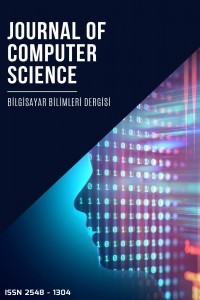Akciğer Kanser Tipi Tespitinde Etkili Bir Görüntü Çoğullama Tekniği
veri çoğullama, otomatik kodlayıcı, aşırı öğrenme makineleri, akciğer kanseri, dalgacık fonksiyonu
An Effective Image Augmenting Technique in Detection of Lung Cancer Types
___
- Shorten, C., & Khoshgoftaar, T. M. (2019). A survey on image data augmentation for deep learning. Journal of big data, 6(1), 1-48.
- Sambasivan, N., Kapania, S., Highfill, H., Akrong, D., Paritosh, P., & Aroyo, L. M. (2021, May). “Everyone wants to do the model work, not the data work”: Data Cascades in High-Stakes AI. In proceedings of the 2021 CHI Conference on Human Factors in Computing Systems (pp. 1-15).
- Zhang, Y., Choon, N. H., Lin, H., Abd Yusof, N. F., Zhang, Y., & Wang, X. (2022). An Overview of Analysis of Medical Images Using Data Visualization and Deep Learning Applications. Forest Chemicals Review, 2321-2332.
- Ingle, K., Chaskar, U., & Rathod, S. (2021, July). Lung Cancer Types Prediction Using Machine Learning Approach. In 2021 IEEE International Conference on Electronics, Computing and Communication Technologies (CONECCT) (pp. 01-06). IEEE.
- Wang, F., Zhong, S. H., Peng, J., Jiang, J., & Liu, Y. (2018, February). Data augmentation for EEG-based emotion recognition with deep convolutional neural networks. In International Conference on Multimedia Modeling (pp. 82-93).
- S. Hussein, R. Gillies, K. Cao, Q. Song, and U. Bagci, "Tumornet:Lung nodule characterization using multi-view convolutional neural network with gaussian process," in 2017 IEEE 14th International Symposium on Biomedical Imaging (ISBI 2017), April 2017, pp. 1007–1010.
- Nishizaki, H. (2017, December). Data augmentation and feature extraction using variational autoencoder for acoustic modeling. In 2017 Asia-Pacific Signal and Information Processing Association Annual Summit and Conference (APSIPA ASC) (pp. 1222-1227). IEEE.
- Frid-Adar, M., Klang, E., Amitai, M., Goldberger, J., & Greenspan, H. (2018, April). Synthetic data augmentation using GAN for improved liver lesion classification. In 2018 IEEE 15th international symposium on biomedical imaging (ISBI 2018) (pp. 289-293). IEEE.
- Ferreira, J., Ferro, M., Fernandes, B., Valenca, M., Bastos-Filho, C., & Barros, P. (2017, November). Extreme learning machine autoencoder for data augmentation. In 2017 IEEE Latin American Conference on Computational Intelligence (LA-CCI)(pp. 1-6). IEEE.
- K. Munir, H. Elahi, A. Ayub, F. Frezza, and A. Rizzi, (2019) Cancer diagnosis using deep learning: A bibliographic review, Cancers (Basel)., 11(9): 1–36, doi: 10.3390/cancers11091235.
- Manikandan, T., Devi, B., & Helanvidhya, T. A (2019) Computer-Aided Diagnosis System for Lung Cancer Detection with Automatic Region Growing, Multistage Feature Selection and Neural Network Classifier.
- Cifci, M. Derin Öğrenme Metodu Kullanarak BT Görüntülerinden Akciğer Kanseri Teşhisi. Dokuz Eylül Üniversitesi Mühendislik Fakültesi Fen ve Mühendislik Dergisi, 24(71), 487-500.
- Mohammed SH (2021), Detection Of Cancer Area In Lung Images With The Help Of Deep Learning Algorithm, Elazığ Chest CT-Scan Images Dataset (2020) Hany M. https://www.kaggle.com/mohamedhanyyy/chest-ctscan-images.
- Wei, K., Li, T., Huang, F., Chen, J., & He, Z. (2022). Cancer classification with data augmentation based on generative adversarial networks. Frontiers of Computer Science, 16(2), 1-11. SPIE-AAPM-NCI BreastPathQ: (2021) http://breastpathq.grand-challenge.org/ April
- Polat M. (2021) Göğüs x-ray görüntülerinde derin öğrenme algoritmaları ile akciğer bölütlemesi, Erzurum
- Kandel, I., Castelli, M., & Manzoni, L. (2022). Brightness as an Augmentation Technique for Image Classification. Emerging Science Journal, 6(4), 881-892.
- Francisco JM-B, Fiammetta S, Jose MJ, Daniel U, Leonardo F. Forward noise adjustment scheme for data augmentation. arXiv preprints. 2018.
- Huang, G. B., Zhu, Q. Y., and Siew, C. K. (2004) Extreme learning machine: a new learning scheme of feedforward neural networks, IEEE International Joint Conference on Neural Networks, Budapest, 25-29 July, 2, 985-990.
- Arı, B. , Alçin, Ö. F. & Şengür, A. (2022). A Lung Sound Classification System Based on Data Augmenting Using ELM-Wavelet-AE . Turkish Journal of Science and Technology , 17 (1) , 79-88 . DOI: 10.55525/tjst.1063039
- Güner, A., Alçin, Ö. F., & Şengür, A. (2019). Automatic digital modulation classification using extreme learning machine with local binary pattern histogram features. Measurement, 145, 214-225.
- Ari, B., Siddique, K., Alçin, Ö. F., Aslan, M., Şengür, A., & Mehmood, R. M. (2022). Wavelet ELM-AE Based Data Augmentation and Deep Learning for Efficient Emotion Recognition Using EEG Recordings. IEEE Access.
- Szegedy, C., Liu, W., Jia, Y., Sermanet, P., Reed, S., Anguelov, D., ... & Rabinovich, A. (2015). Going deeper with convolutions. In Proceedings of the IEEE conference on computer vision and pattern recognition (pp. 1-9)
- Toğaçar, M., & Ergen, B. (2019). Biyomedikal Görüntülerde Derin Öğrenme ile Mevcut Yöntemlerin Kıyaslanması. Fırat Üniversitesi Mühendislik Bilimleri Dergisi, 31(1), 109-121.
- Chicco, D., & Jurman, G. (2020). The advantages of the Matthews correlation coefficient (MCC) over F1 score and accuracy in binary classification evaluation. BMC genomics, 21(1), 1-13.
- Rehman, A., Kashif, M., Abunadi, I., & Ayesha, N. (2021). Lung cancer detection and classification from chest CT scans using machine learning techniques. In 2021 1st International Conference on Artificial Intelligence and Data Analytics (CAIDA) (pp. 101-104). IEEE.
- Sadhu A, Mehra A, Kulshrestha A, Goyal V. (2022) Cancer detection from medical images using deep convolution neural networks. Int J Adv Res Comput Commun Eng. ;11(3):70–81.
- ISSN: 2548-1304
- Yayın Aralığı: Yılda 2 Sayı
- Başlangıç: 2016
- Yayıncı: Ali KARCI
Application of Slime Mould Algorithm to Infinite Impulse Response System Identification Problem
Davut İZCİ, Serdar EKİNCİ, Murat GÜLEYDİN
EMG Sinyallerinin HFD Analizi ve Hareket Sınıflandırılması
Gazi AKGÜN, Uğur DEMİR, Alper YILDIRIM
Beyin Tümörü Bölütleme ve Algılamada Yeni Çekişmeli Üretken Ağ Kullanılması
Sara ALTUN GÜVEN, Muhammed Fatih TALU
Denim Kumaşından Otomatik Yüksek Çözünürlüklü Bıyık Desen Sentezi
Emrullah ŞAHİN, Muhammed Fatih TALU
Muhammed Saadetdin KAYA, Kenan İNCE
Transfer Learning-Based Classification Comparison of Stroke
Rusul Ali Jabbar ALHATEMİ, Serkan SAVAŞ
IoT Botnet Verisetlerinin Karşılaştırmalı Analizi
Akademik Yazılarda Resim İntihal Kontrolü Sistemi
Jansen Bağlantısının Kinematik Analizi için Araç Kutusu Tasarımı
Semir SÜNKÜN, Berke Oğulcan PARLAK, Alper YILDIRIM, Hüseyin Ayhan YAVAŞOĞLU
